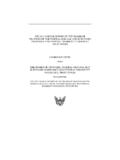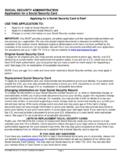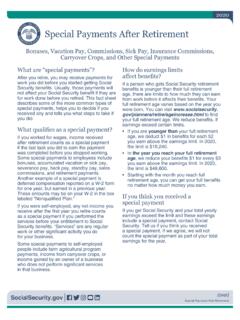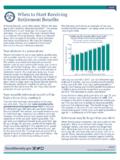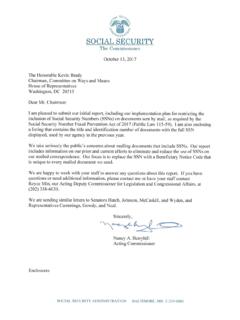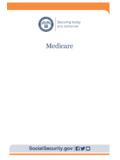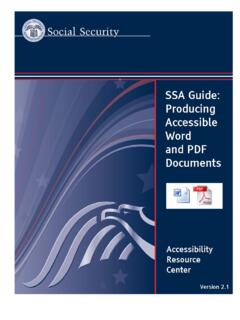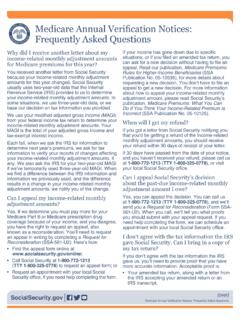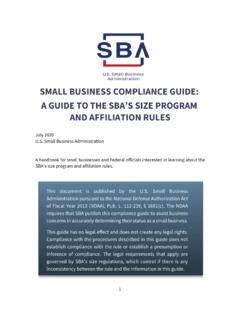Transcription of Old-Age, Survivors, and Disability Insurance
1 100 80 60 4020 0 Old-Age, survivors , and DisabilityInsurance The OASDI program which for most Americans means Social Security is the largest income-maintenance program in the United States. Based on social Insurance principles, the program provides monthly benefits designed to replace, in part, the loss of income due to retirement, Disability , or death. Coverage is nearly universal: About 96% of the jobs in the United States are finance the program through a payroll tax that is levied under the Federal Insurance and Self-Employment Contri-bution Acts (FICA and SECA).The revenues are deposited in two trust funds (the Federal Old-Age and survivors Insurance Trust Fund and the Federal Disability Insurance Trust Fund), which pay benefits and the operating expenses of the program. Benefit payments totaled over $ billion in fiscal year 1996, million persons received monthly benefits In December 1996, million persons were receiving monthly benefits totaling $ billion. These beneficiaries in-cluded million retired workers and their spouses and chil-dren, million survivors of deceased workers, and million disabled workers and their spouses and children.
2 Social Security is an important source of retirement income for almost everyone; 3 in 5 beneficiaries aged 65 or older rely on it for at least half of their income. Social Security is also an important source of continuing income for young survivors of deceased workers: 98% of young children and their mothers or fathers are eligible for benefits should a working parent die. Four in five workers aged 21-64 and their families have protection in the event of a long-term The Social Security Act of 1935 covered employees in nonagricultural industry and commerce only. Today, almost all jobs are all work per-formed by citizens and noncitizens is covered if it is performed within the United States (defined for Social Security purposes to include all 50 States, the District of Columbia, the 9 Program Principles Certain fundamental principles have shaped the development of the Social Security program. These basic principles are largely responsible for the program s widespread acceptance and support: Work Related.)
3 Economic security for workers and their families is based on their work history. Entitlement to benefits and the benefit level are related to earnings in covered work. No Means Test Benefits are an earned right and are paid regardless of income from savings, pensions, private Insurance , or other forms of nonwork income. Contributory The concept of an earned right is reinforced by the fact that workers make contributions to help finance the benefits. Universal Compulsory Coverage Workers at all income levels and their families have protection if earnings stop or are reduced due to retirement, Disability , or nearly all employment covered by Social Security, this protection continues when workers change jobs. Rights Clearly Defined in the Law. How much a person gets and under what conditions are clearly defined in the law and are generally related to facts that can be objectively area of administrative discretion is se-verely limited. Monthly OASDI benefits and average amountNumber of beneficiaries December Type of beneficiary 1940 1960 1980 1996 Averageamount, December 1996 All beneficiaries 222,488 14,844,589 35,618,840 43,736,836 $ Retirement program 148,490 10,599,021 23,243,078 30,310,865 workers 112,331 8,061,469 19,582,625 26,898,072 Wives and husbands 29,749 2,269,384 3,018,008 2,970, 6,410 268,168 642,445 442,567 Survivor program 73,998 3,558,117 7,600,836 7,353,284 widows and widowers 4,437 1,543,843 4,287,930 5,027,901 widows and widowers.
4 126,659 181,911 Widowed mothers and fathers 20,499 401,358 562,798 242, 48,238 1,576,802 2,608,653 1,897,667 824 36,114 14,796 3,670 Disability program .. 687,451 4,682,172 6,072,034 workers .. 455,371 2,861,253 4,385,623 Wives and husbands .. 76,599 462,204 223, .. 155,481 1,358,715 1,462,557 Special age-72 beneficiaries .. 92,754 653 10 SOCIAL Insurance PROGRAMSC ommonwealth of Puerto Rico, the territories of Guam and American Samoa, the Virgin Islands, and the Northern Mariana Islands). In addition, the program covers work performed outside the United States by American citizens or resident aliens who are employed by an American employer, employed by a foreign affiliate of an American employer electing coverage for its employ-ees, or (under certain circumstances) the self-employed. Major ExclusionsMajor ExclusionsMajor ExclusionsMajor ExclusionsMajor ExclusionsFederal civilian employees hired before 1/1/84 Agricultural workers and domestic workers whose earnings do not meet certain minimum require-ments Persons with very low net earnings from self-employment The majority of workers excluded from coverage are in three major categories: (1) Federal civilian employees hired before January 1, 1984, (2) agricultural workers and domestic workers whose earnings do not meet certain minimum requirements, and (3) persons with very low net earnings from self-employment (generally less than $400 per year).
5 The remaining few groups excluded from coverage are very small. An example is certain nonresident, nonimmigrant aliens temporarily admitted into the United States to study, teach, or conduct research. Certain family employment is also excluded (such as employment of children under age 18 by their parents). Ministers and members of religious orders who have not taken a vow of poverty and Christian Science practitioners have their professional services covered automatically as self-employ-ment unless within a limited period they elect not to be covered on the grounds of conscience or religious principle. Religious orders whose members have taken a vow of poverty may make an irrevocable election to cover their members as employees. Employees of State and local governments are covered under voluntary agreements between the States and the Commissioner of Social Security. Each State decides whether it will negotiate an agreement and, subject to special conditions that apply to retire-ment system members, what groups of eligible employees will be covered.
6 At present, more than 75% of State and local employees are covered. Special rules of coverage apply to railroad workers and members of the uniformed services . Railroad workers have their own Federal Insurance system that is closely coordinated with the Social Security program. If they have less than 10 years of rail-road service, their railroad credits are transferred to the Social Security program. Under certain circumstances, members of the uniformed services may be given noncontributory wage credits in addition to the credits they receive for basic pay. The Social Security Trust Funds are reimbursed from Federal general rev-enues to finance noncontributory wage credits. Eligibility for Benefits To qualify for Social Security a person must be insured for benefits. Most types of benefits require fully insured status, which is obtained by acquiring a certain number of credits (also called 11 OLD-AGE, survivors , AND Disability INSURANCEIn 1997, workers earn one Social Security credit for each $670 of annual earnings, up to four credits ($2,680 = 4 credits) per year quarters of coverage) from earnings in covered employment.
7 The number of credits needed depends on the worker s age and type of benefit. Workers can acquire up to four credits per year, depending on their annual covered earnings. In 1997, one credit is acquired for each $670 in covered earnings. This earnings figure is updated annually, based on increases in average wages. Retirement and survivors Insurance Persons are fully insured for benefits if they have at least as many credits ( acquired at any time after 1936) as the number of full calendar years elapsing after age 21 and before age 62, Disability , or death, whichever occurs first. For workers who attained age 21 before 1951, the requirement is one credit for each year after 1950 and before the year of attainment of age 62, Disability , or death. Persons reaching age 62 after 1990 need 40 credits to qualify for retirement benefits. For workers who die before acquiring fully insured status, certain survivor benefits are payable if they were currently in-sured that is, they acquired 6 credits in the 13-quarter period ending with the quarter in which they died.
8 Annual Earnings Test. Beneficiaries may have some or all benefits withheld, depending on the amount of their annual earn-ings. Benefits payable to a spouse and/or child may also be re-duced or withheld due to the earnings of the retired worker. This provision, known as the earnings test (or retirement test) is in line with the purpose of the program to replace some of the earnings from work that are lost because of the worker s retirement, disabil-ity, or death. 1997 Ear1997 Ear1997 Ear1997 Ear1997 Earningsningsnings ningsningsTTTTT estestestestestAge 70 No limit Age 65-69 $1 less for every $3 over $13,500 Under age 65 $1 less for every $2 over $8,640 The dollar amount beneficiaries can earn without having their benefits reduced depends on their age. Persons aged 70 or older receive full benefits regardless of their earnings. In 1997, benefits for persons under age 65 are reduced $1 for each $2 of annual earnings in excess of $8,640; benefits for persons aged 65-69 are reduced $1 for each $3 of earnings above $13,500.
9 The exempt amounts for persons aged 65-69 will increase gradually to $30,000 in 2002, while amounts for those under age 65 will be indexed to the growth in average wages. After the year 2002, amounts for persons aged 65-69 will also be indexed to increases in average wages. A foreign work test applies to beneficiaries who work outside the United States in noncovered employment. Benefits are withheld for any month in which more than 45 hours of work is performed. Generally, any benefits to family members are also withheld. The test is based on the amount of time the beneficiary is employed rather than on the amount of money the beneficiary earns because 12 SOCIAL Insurance PROGRAMSit is impractical to convert earnings in a foreign currency into specific dollar amounts. Disability Insurance To be eligible for Disability benefits, workers must be fully insured and must meet a test of substantial recent covered work that is, they must have credit for work in covered employ-ment for at least 20 quarters of the 40 calendar quarters ending with the quarter the Disability workers disabled before age 31 may qualify for benefits under a special insured status requirement.
10 They must have credits in one-half the calen-dar quarters after age 21, up to the date of their Disability , or, if disabled before age 24, one-half the quarters in the 3 years ending with the quarter of Disability . Blind workers need only to be fully insured to qualify for benefits. Disability Determination. For purposes of entitlement, dis-ability is defined as the inability to engage in any substantial gainful activity (SGA) by reason of any medically determinable physical or mental impairment that can be expected to result in death or that has lasted or can be expected to last for a continu-ous period of not less than 12 months. A person s age, educa-tion, and work experience are considered along with the medical evidence in making a determination of Disability . A less strict rule is provided for blind workers aged 55 or older. Such workers are considered disabled if, because of their blindness, they are unable to engage in SGA requiring skills and abilities comparable to those required in their past occupations.
